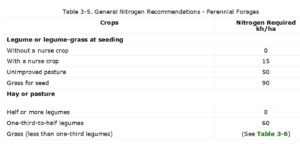Cereals
Winter wheat survival is quite variable across the region. Survival is better in western Ontario. As a guideline, a good stand is 12 to 18 plants per foot of row. See Agronomy Guide, Table 4-8 Determining Yield Potential for Various Plant Stand Counts. 7 plants per foot of row, evenly distributed has a 90% yield potential.

Only some nitrogen has been applied on winter wheat and winter rye to date. Nitrogen rates up to 120 pounds per acre.
Sulphur on Wheat – project underway again in 2013. General recommendation of 1 kg per 10 kg of nitrogen applied. See article – Do I need to apply sulphur to winter wheat?
Very few acres of spring cereals were frost seeded this year.
Forages
Alfalfa Stand Survival – need a few more warm day to get a clear picture, but significant losses in some areas. Dead plants are easy to pull out in most cases. Generally, new seedings with stubble left overwinter fared better than older stands or stands harvested last fall. It will be important to walk fields in about a week to assess individual stands. Note, just because there are new shouts emerging doesn’t mean that the plant will survive. Often damaged plants will put out 1 to 3 inches shoots growth and then die off.
Forage supplies are scarce, with prices in the $40 to $60 range for a 4X5 bale.
Winter Cereal Crops as a Forage – Trial
• Trial initiated across Ontario fall 2012 with Winter Triticale, Winter Rye & Winter Wheat and some locations with Winter Barley.
• Planted in October 10th at the Winchester Research Farm
• Poor winter survival with all species accept for winter rye this year.
Cereal Companion Crop as an Annual Forage (Source-Jim Johnston, NLARS):
• Oats, Barley and/or Triticale – yields similar
• Plant Early – As soil conditions permit
• Use the nitrogen rate recommended for the cereal crop
• Harvest Early – to have quality – quality declines rapidly once in boot stage
• Harvest 2nd Crop – if companion crop cut early enough; ie. before heading stage.
Adding Peas to the cereal companion crop
•increase Crude Protein by 2 – 4%
•decrease NDF by 2 – 6%
•need to include 50:50 peas:cereal – COSTLY
Forage Yield vs Quality
• if harvested at the Boot stage – Yield = 1.6 Ton/acre, CP = 15.7, TDN = 65.1
• if harvested at the Milk stage – Yield = 2.5 Ton/acre, CP = 11.2, TDN = 61.8
Annual Ryegrass (Jim Johnson 1993, 94 & 95 – Kemptville, Verner & New Liskeard) :
• Summary – Under good conditions, annual ryegrass can provide high yields of average quality, highly palatable forage. Under poor seedbed conditions, annual ryegrass yield will often be disappointing. Three cuts per year are possible, although two cuts followed by a grazing pass may be more practical. Aftermath growth is very dependent on rainfall. Although not part of the experiment, topdressing liquid manure after each harvest should boost yield and crude protein content of the regrowth. Annual ryegrass is ideal for late fall grazing since it continues growing into October and winter survival is not a consideration.
NITROGEN ON FORAGE STANDS
• Limiting Factors: Rain, Nitrates in feed
• Nitrogen increases grass stand density, height, and protein content


Corn
At this time, acreage intended for corn is similar to that of 2012.
Soybeans
As with corn, soybean acreage should be similar to that of 2012. At this time, the intented IP acreage is down in part due to Group II herbicide resistance.
Research at the Winchester Research Farm has shown that a yield gain of 5 bu/acre or more can be obtained by planting longer-day soybeans varieties (about 200 heat units longer than the traditional ‘adapted’ varieties). Certainly worth a try on some acreage. Best yields are obtained when soybeans are planted between May 5 to 15.
Weed Resistance: Acreage with Group II resistant weeds (pigweeds, lamb’s quarters, common ragweed and black nightshade) is rapidly increasing. Also picking up more weeds (mostly pigweeds) resistant to both, Group II and triazines.
Forage program changes for 2013
- Maximum coverage has increased from $300 to $400 per acre due to the higher hay prices.
- Growers can opt to change rain station locations.
Deadlines: April 30, 2013 for:
- AgStab – Cancel coverage
- AgStab – Pay fee
- AgStab – Submit New Participant Form
- RMP – Enrol in AgriStability and pay fee
- RMP – Submit 2013 coverage changes for existing participants.
- RMP – Report sales
May 01, 2013
- PI – Pay premium balance
- PI – Apply or make changes
- PI – USAB: apply and report acreage changes
- PI – Pay premium
- PI – Submit farm diagrams
- PI – Submit your planting intention
- PI – Cancel coverage
Resources:
Protecting Pollinators During Corn Planting Season
WeedPro75 – Herbicide Selector
Eastern Ontario Crop Diagnostic Day will be on Tuesday, July 16, 2013 at the Winchester Research Farm of the University of Guelph, Kemptville Campus.
Next Meeting Date: Tuesday, April 30, 2013 at 7:30 a.m. at the Country Kitchen Restaurant, 31 Highway, Winchester, Ontario.
Scott Banks (613) 294-4436
Scott.Banks@ontario.ca
Twitter: @EastCropper
Gilles Quesnel (613) 294-4457
Gilles.Quesnel@ontario.ca
Twitter: @GillesQuesnel
